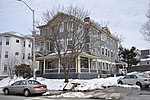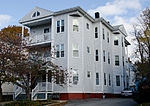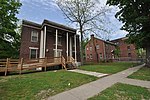Catherine Ahern Three-Decker
Apartment buildings in Worcester, MassachusettsApartment buildings on the National Register of Historic Places in MassachusettsHouses completed in 1888Italianate architecture in MassachusettsNational Register of Historic Places in Worcester, Massachusetts ... and 2 more
Triple-decker apartment housesWorcester, Massachusetts Registered Historic Place stubs

The Catherine Ahern Three-Decker is a historic triple decker in Worcester, Massachusetts. It is a well-preserved example of a triple-decker that predates the popularity of that building type. Built in 1888, it has Italianate design details, including a low pitch hipped roof, and a decorated porch sheltering the front door. It is unusual in that its long side faces the street. Its first documented owner was Catherine Ahern.The building was listed on the National Register of Historic Places in 1990.
Excerpt from the Wikipedia article Catherine Ahern Three-Decker (License: CC BY-SA 3.0, Authors, Images).Catherine Ahern Three-Decker
Cambridge Street, Worcester
Geographical coordinates (GPS) Address Nearby Places Show on map
Geographical coordinates (GPS)
| Latitude | Longitude |
|---|---|
| N 42.243611111111 ° | E -71.822222222222 ° |
Address
Cambridge Street 204
01610 Worcester
Massachusetts, United States
Open on Google Maps











